 Journal of Environmental Protection, 2013, 4, 28-39 http://dx.doi.org/10.4236/jep.2013.48A1005 Published Online August 2013 (http://www.scirp.org/journal/jep) Artificial Neural Network Modeling of Healthy Risk Level Induced by Aircraft Pollutant Impacts around Soekarno Hatta International Airport Salah Khardi1, Jermanto Setia Kurniawan2, Irwan Katili2, Setyo Moersidik2 1Transports and Environment Laboratory, French Institute of Science and Technology for Transport, Development and Networks (IFSTTAR), Bron, France; 2Department of Civil Engineering, Faculty of Engineering, University of Indonesia, Kampus Baru UI, Depok, Indonesia. Email: Salah.khardi@ifsttar.fr Received May 30th, 2013; revised July 2nd, 2013; accepted August 1st, 2013 Copyright © 2013 Salah Khardi et al. This is an open access article distributed under the Creative Commons Attribution License, which permits unrestricted use, distribution, and reproduction in any medium, provided the original work is properly cited. ABSTRACT Aircraft pollutant emissions are an important part of sources of pollution that directly or indirectly affect human health and ecosystems. This research suggests an Artificial Neural Network model to determine the healthy risk level around Soekarno Hatta International Airport-Cengkareng Indonesia. This ANN modeling is a flexible method, which enables to recognize highly complex non-linear correlations. The network was trained with real measurement data and updated with new measurements, enhancing its quality and making it the ideal method for this research. Measurements of air- craft pollutant emissions are carried out with the aim to be used as input data and to validate the developed model. The obtained results concerned the improved ANN architecture model based on pollutant emissions as input variables. ANN model processes variables—hidden layers—and gives an output variable corresponding to a healthy risk level. This model is characterized by a 4-10-1 scheme. Based on ANN criteria, the best validation performance is achieved at ep- och 28 from 34 epochs with the Mean Squared Error (MSE) of 9 × 10−3. The correlation between targets and outputs is confirmed. It validated a close relationship between targets and outputs. The network output errors value approaches zero. Further research is needed with the aim to enlarge the scheme of the ANN model by increasing its input variables. This is one of the major key defining environmental capacities of an airport that should be applied by Indonesian airport authorities. These would institute policies to manage or reduce pollutant emissions considering population and income growth to be socially positive. Keywords: Aircraft; Pollutant Emissions; Artificial Neural Network; Healthy Risk Level 1. Introduction The continuing growth in air traffic and increasing public awareness have made environmental considerations one of the most critical aspects of commercial aviation. It is generally accepted that significant improvements to the environmental acceptability of aircraft will be needed if the long-term growth of air transport is to be sustained. This is an open issue. The release of exhaust gasses in the atmosphere is the second major environmental issue associated with commercial airliners. The expected dou- bling of the fleet in the next twenty years will certainly exacerbate the issue: the contribution of aviation is ex- pected to increase by factor of 1.6 to 10, depending on the fuel use scenario. Being conscious of this problem, engine manufacturers have developed low-emission combustors, and made them available as options. These combustors have been adopted by airlines operating in European airports with strict emissions controls, in Swe- den and Switzerland, for example. Significant progress has been made with some individual pollutants rather than with others. Aircraft emissions have also declined over time when consider the emissions from transporting one passenger one mile. Current emissions regulations have focused on local air quality in the vicinity of airports and the research will also focus on the local impact of Avia- tion [1,2]. Emissions released during cruise in the upper atmosphere are recognized as an important issue with potentially severe long-term environmental consequences, and ICAO is actively seeking support for regulating them Copyright © 2013 SciRes. JEP 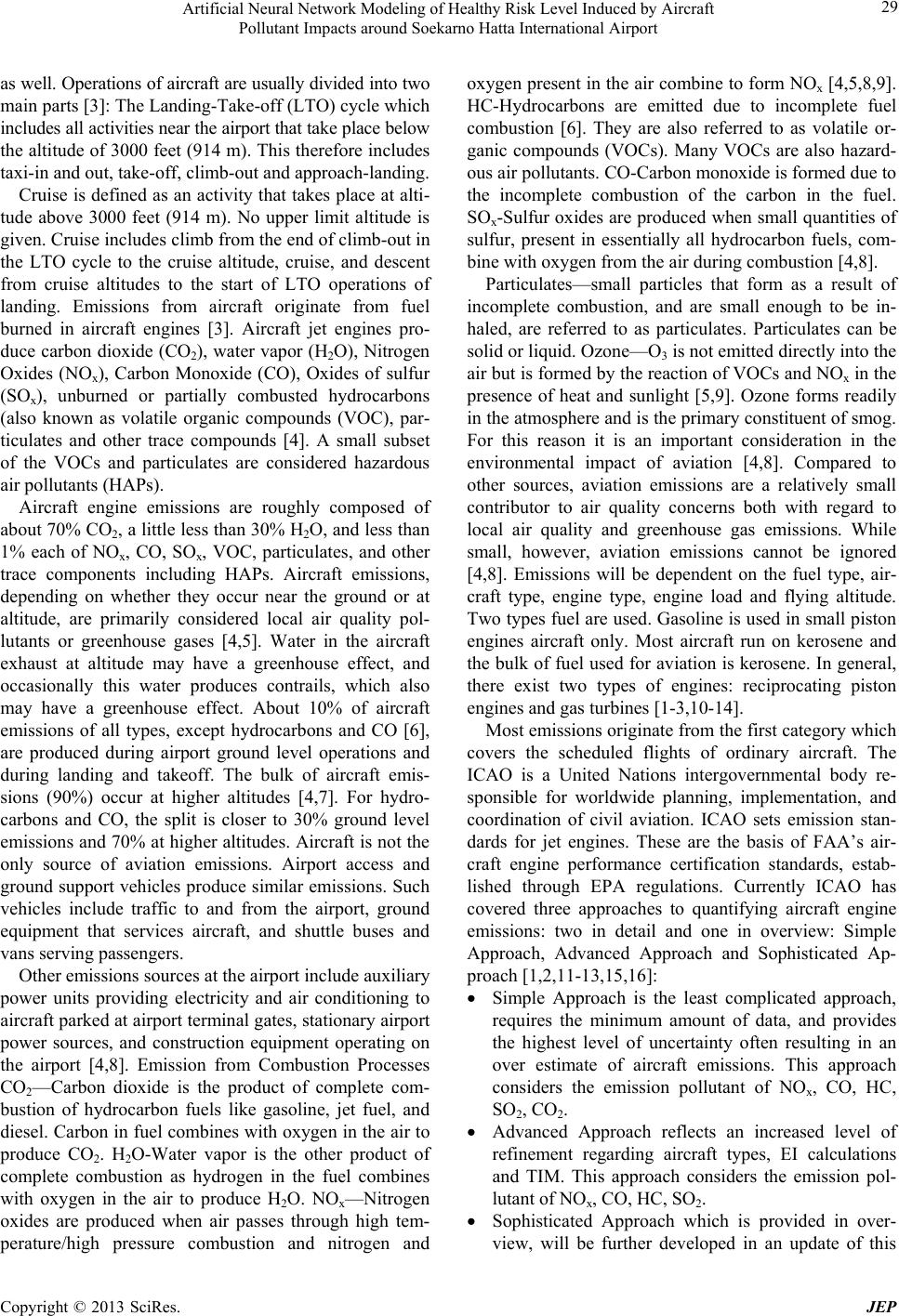 Artificial Neural Network Modeling of Healthy Risk Level Induced by Aircraft Pollutant Impacts around Soekarno Hatta International Airport 29 as well. Operations of aircraft are usually divided into two main parts [3]: The Landing-Take-off (LTO) cycle which includes all activities near the airport that take place below the altitude of 3000 feet (914 m). This therefore includes taxi-in and out, take-off, climb-out and approach-landing. Cruise is defined as an activity that takes place at alti- tude above 3000 feet (914 m). No upper limit altitude is given. Cruise includes climb from the end of climb-out in the LTO cycle to the cruise altitude, cruise, and descent from cruise altitudes to the start of LTO operations of landing. Emissions from aircraft originate from fuel burned in aircraft engines [3]. Aircraft jet engines pro- duce carbon dioxide (CO2), water vapor (H2O), Nitrogen Oxides (NOx), Carbon Monoxide (CO), Oxides of sulfur (SOx), unburned or partially combusted hydrocarbons (also known as volatile organic compounds (VOC), par- ticulates and other trace compounds [4]. A small subset of the VOCs and particulates are considered hazardous air pollutants (HAPs). Aircraft engine emissions are roughly composed of about 70% CO2, a little less than 30% H2O, and less than 1% each of NOx, CO, SOx, VOC, particulates, and other trace components including HAPs. Aircraft emissions, depending on whether they occur near the ground or at altitude, are primarily considered local air quality pol- lutants or greenhouse gases [4,5]. Water in the aircraft exhaust at altitude may have a greenhouse effect, and occasionally this water produces contrails, which also may have a greenhouse effect. About 10% of aircraft emissions of all types, except hydrocarbons and CO [6], are produced during airport ground level operations and during landing and takeoff. The bulk of aircraft emis- sions (90%) occur at higher altitudes [4,7]. For hydro- carbons and CO, the split is closer to 30% ground level emissions and 70% at higher altitudes. Aircraft is not the only source of aviation emissions. Airport access and ground support vehicles produce similar emissions. Such vehicles include traffic to and from the airport, ground equipment that services aircraft, and shuttle buses and vans serving passengers. Other emissions sources at the airport include auxiliary power units providing electricity and air conditioning to aircraft parked at airport terminal gates, stationary airport power sources, and construction equipment operating on the airport [4,8]. Emission from Combustion Processes CO2—Carbon dioxide is the product of complete com- bustion of hydrocarbon fuels like gasoline, jet fuel, and diesel. Carbon in fuel combines with oxygen in the air to produce CO2. H2O-Water vapor is the other product of complete combustion as hydrogen in the fuel combines with oxygen in the air to produce H2O. NOx—Nitrogen oxides are produced when air passes through high tem- perature/high pressure combustion and nitrogen and oxygen present in the air combine to form NOx [4,5,8,9]. HC-Hydrocarbons are emitted due to incomplete fuel combustion [6]. They are also referred to as volatile or- ganic compounds (VOCs). Many VOCs are also hazard- ous air pollutants. CO-Carbon monoxide is formed due to the incomplete combustion of the carbon in the fuel. SOx-Sulfur oxides are produced when small quantities of sulfur, present in essentially all hydrocarbon fuels, com- bine with oxygen from the air during combustion [4,8]. Particulates—small particles that form as a result of incomplete combustion, and are small enough to be in- haled, are referred to as particulates. Particulates can be solid or liquid. Ozone—O3 is not emitted directly into the air but is formed by the reaction of VOCs and NOx in the presence of heat and sunlight [5,9]. Ozone forms readily in the atmosphere and is the primary constituent of smog. For this reason it is an important consideration in the environmental impact of aviation [4,8]. Compared to other sources, aviation emissions are a relatively small contributor to air quality concerns both with regard to local air quality and greenhouse gas emissions. While small, however, aviation emissions cannot be ignored [4,8]. Emissions will be dependent on the fuel type, air- craft type, engine type, engine load and flying altitude. Two types fuel are used. Gasoline is used in small piston engines aircraft only. Most aircraft run on kerosene and the bulk of fuel used for aviation is kerosene. In general, there exist two types of engines: reciprocating piston engines and gas turbines [1-3,10-14]. Most emissions originate from the first category which covers the scheduled flights of ordinary aircraft. The ICAO is a United Nations intergovernmental body re- sponsible for worldwide planning, implementation, and coordination of civil aviation. ICAO sets emission stan- dards for jet engines. These are the basis of FAA’s air- craft engine performance certification standards, estab- lished through EPA regulations. Currently ICAO has covered three approaches to quantifying aircraft engine emissions: two in detail and one in overview: Simple Approach, Advanced Approach and Sophisticated Ap- proach [1,2,11-13,15,16]: Simple Approach is the least complicated approach, requires the minimum amount of data, and provides the highest level of uncertainty often resulting in an over estimate of aircraft emissions. This approach considers the emission pollutant of NOx, CO, HC, SO2, CO2. Advanced Approach reflects an increased level of refinement regarding aircraft types, EI calculations and TIM. This approach considers the emission pol- lutant of NOx, CO, HC, SO2. Sophisticated Approach which is provided in over- view, will be further developed in an update of this Copyright © 2013 SciRes. JEP 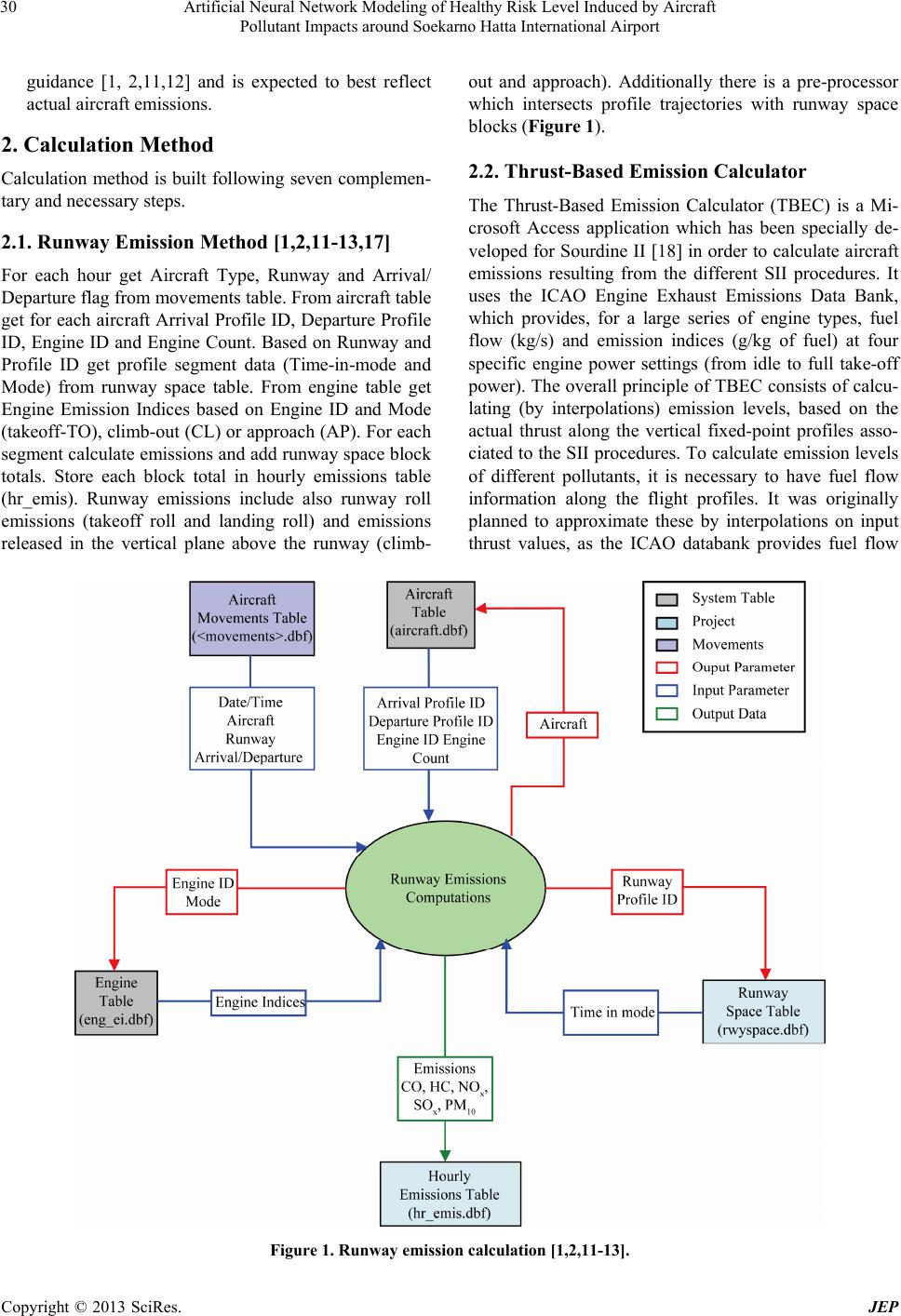 Artificial Neural Network Modeling of Healthy Risk Level Induced by Aircraft Pollutant Impacts around Soekarno Hatta International Airport Copyright © 2013 SciRes. JEP 30 out and approach). Additionally there is a pre-processor which intersects profile trajectories with runway space blocks (Figure 1). guidance [1, 2,11,12] and is expected to best reflect actual aircraft emissions. 2. Calculation Method 2.2. Thrust-Based Emission Calculator Calculation method is built following seven complemen- tary and necessary steps. The Thrust-Based Emission Calculator (TBEC) is a Mi- crosoft Access application which has been specially de- veloped for Sourdine II [18] in order to calculate aircraft emissions resulting from the different SII procedures. It uses the ICAO Engine Exhaust Emissions Data Bank, which provides, for a large series of engine types, fuel flow (kg/s) and emission indices (g/kg of fuel) at four specific engine power settings (from idle to full take-off power). The overall principle of TBEC consists of calcu- lating (by interpolations) emission levels, based on the actual thrust along the vertical fixed-point profiles asso- ciated to the SII procedures. To calculate emission levels of different pollutants, it is necessary to have fuel flow information along the flight profiles. It was originally planned to approximate these by interpolations on input thrust values, as the ICAO databank provides fuel flow 2.1. Runway Emission Method [1,2,11-13,17] For each hour get Aircraft Type, Runway and Arrival/ Departure flag from movements table. From aircraft table get for each aircraft Arrival Profile ID, Departure Profile ID, Engine ID and Engine Count. Based on Runway and Profile ID get profile segment data (Time-in-mode and Mode) from runway space table. From engine table get Engine Emission Indices based on Engine ID and Mode (takeoff-TO), climb-out (CL) or approach (AP). For each segment calculate emissions and add runway space block totals. Store each block total in hourly emissions table (hr_emis). Runway emissions include also runway roll emissions (takeoff roll and landing roll) and emissions released in the vertical plane above the runway (climb- Figure 1. Runway emission calculation [1,2,11-13].  Artificial Neural Network Modeling of Healthy Risk Level Induced by Aircraft Pollutant Impacts around Soekarno Hatta International Airport 31 data associated to specific power settings. However, the International Civil Aviation Organization Committee on Aviation Environmental Protection (CAEP)’s Modeling Working Group (WG2) considered that estimating fuel flow based on thrust was unsatisfactory without having a greater knowledge of individual aircraft/engine perform- ance parameters, data that is not yet readily available. Consequently, realistic fuel flow data have been supplied by Airbus for all the studied SII procedures (along with the baseline procedures) and for the eight Airbus aircraft. These fuel flow data have been incorporated, as an addi- tional parameter. Based on the fuel flow and thrust val- ues along the flight profiles, TBEC calculates total fuel burn (a straight forward process), and emission levels of different pollutants. Calculation of arrival emissions stops at touchdown since the fuel-flow data available stop at that point. Reverse thrust emissions are not taken into account. These would vary as a function of the landing speed of the aircraft, which is very slightly higher in the Sourdine II procedures than the baseline due to the different landing configurations used. TBEC inputs: TBEC calculates fuel burn and emission levels for the fixed-point profiles of the SII flight profile data- base, which include the additional fuel flow parameter (Airbus aircraft only). These input fixed-point profiles provide altitude (ft), speed (kts), corrected net thrust (lbs) and fuel flow (kg/s) as a function of the ground distance (ft) from brake release (for departures), or to touchdown (for arrivals). For a given flight profile, TBEC calculates total fuel burn and total emissions (in kgs) of the following com- ponents: HC, CO, NOx, SO2, CO2, H2O, VOC, total or- ganic gases (TOG). VOC are Acetaldehyde, Acrolein, POM16PAH, POM7PAH, Styrene. TOG are Formalde- hyde, Propianaldehyde, Toluene, Xylene, 1-3Butadiene, Benzene, Ethylbenzene. The calculation of total fuel burn is a straight forward process: it is obtained by the time integration of the input fuel flow data along the profile. HC, CO and NOx are obtained by linear interpolations in the ICAO databank, using as input data the corrected net thrust and the fuel flow on the successive segments of the profile. CO2, SO2 and H2O emissions are proportional to fuel burn (or fuel flow), and are obtained using emission coefficients (kg/kg fuel flow, or g/kg fuel flow for SO2). The VOC and TOG emissions are obtained in a similar way from the calculated emissions of HC. All these emission coefficients are independent of the engine type. Calculation principle: The flight profile is defined by a series of small segments, each segment being defined by two consecutive points of the fixed-point profile. The overall calculation principle consists of estimating the fuel burn and emission levels produced by each segment, and summing them (over the flight profile) to obtain the total fuel burn and emissions of each pollutant. 2.3. Fuel Burn The fuel burn on a trajectory segment FBseg is calculated as follows: segseg seg FBT FF where ∆Tseg is the duration (in seconds) of the flight segment. ∆Tseg is calculated using the distance between the two end-points of the segment, divided by the average speed of the aircraft on the segment; FFseg is the average fuel flow on the segment (kg/s), calculated using the input fuel flow values at the two end-points of the segment. 2.4. HC, CO and NOx The ICAO Engine Exhaust Emissions Data Bank pro- vides emission indices (g/kg fuel flow) at four different power setting levels, namely: Take-Off, Climb-Out, Ap- proach, and Idle. These four power states correspond to a%age of Foo, the maximum engine thrust available for take-off under normal operating conditions at ISA sea level static conditions. By definition, the four tabulated power settings correspond respectively to 100%, 85%, 30% and 7% of Foo (Similar to ALAQS [17]. The emis- sions of HC, CO and NOx on a segment are calculated through a linear interpolation between the above tabu- lated emission data. The different steps of the process are described below. The Emission Indices EI (Pi) of each pollutant provided by the ICAO data bank at the four power settings are converted into segment-specific emis- sion flow EFseg (Pi) as follows: seg iiseg EFPEI PFF where EFseg (Pi) is the emission flow for the segment associ- ated to power setting Pi (in g/s). Pi is one of the tabu- lated engine power settings for which emission indi- ces are provided in the data bank (7%, 30%, 85% or 100%). EI (Pi) is the emission indices associated to power setting Pi (in g/kg of fuel). FFseg is the average fuel flow on the segment (in kg/s), calculated using the input fuel flow values at the two end-points of the segment. The segment-specific power setting pa- rameter Pseg, at which the emission levels will be in- terpolated, is approximated as follows: seg seg CNT P1 MaxStaticThrust 00 where Pseg is the segment-specific power setting (%); Copyright © 2013 SciRes. JEP 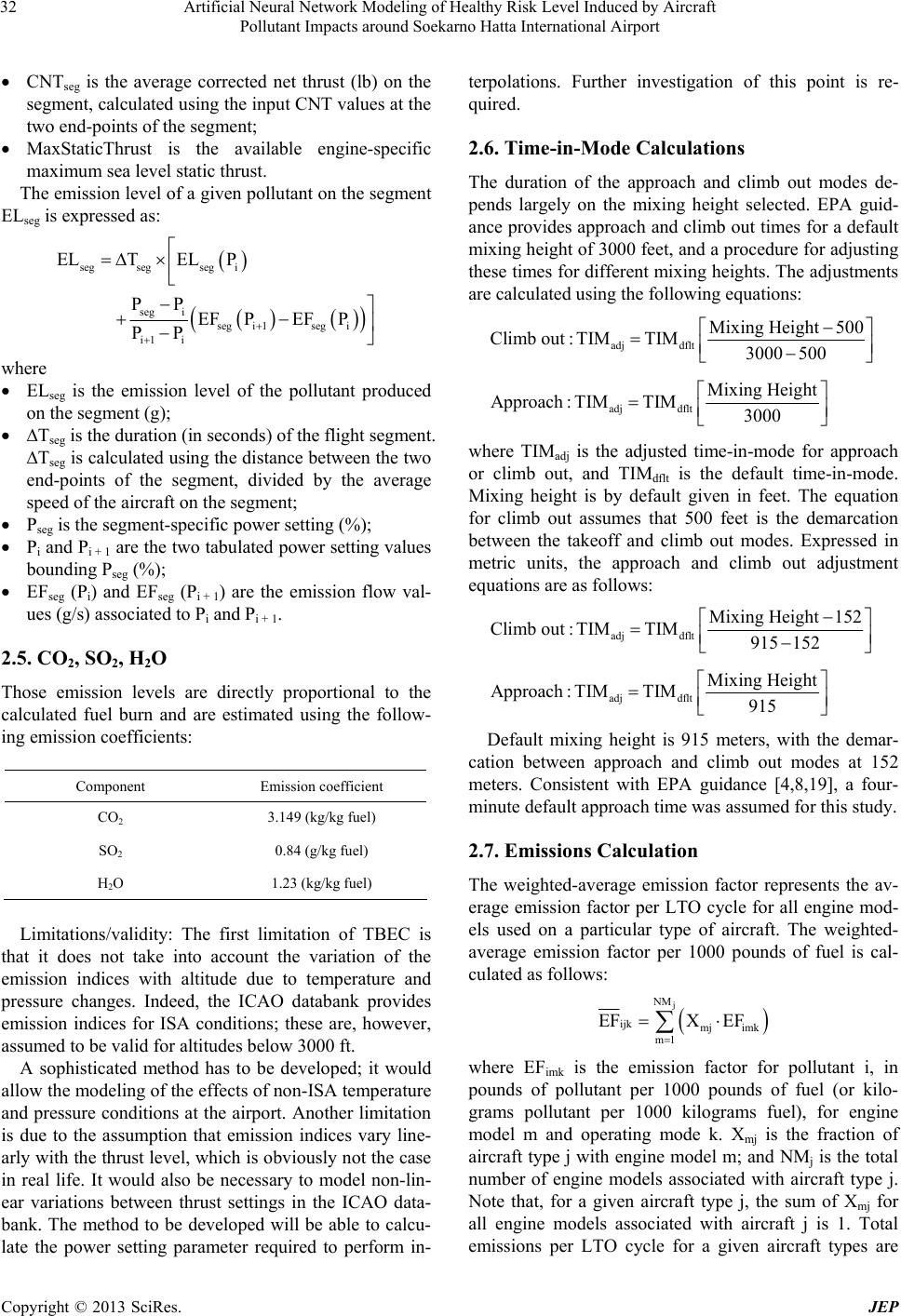 Artificial Neural Network Modeling of Healthy Risk Level Induced by Aircraft Pollutant Impacts around Soekarno Hatta International Airport 32 CNTseg is the average corrected net thrust (lb) on the segment, calculated using the input CNT values at the two end-points of the segment; MaxStaticThrust is the available engine-specific maximum sea level static thrust. The emission level of a given pollutant on the segment ELseg is expressed as: segsegsegi seg i segi1segi i1 i ELTEL P PP EF PEF P PP where ELseg is the emission level of the pollutant produced on the segment (g); ∆Tseg is the duration (in seconds) of the flight segment. ∆Tseg is calculated using the distance between the two end-points of the segment, divided by the average speed of the aircraft on the segment; Pseg is the segment-specific power setting (%); Pi and Pi + 1 are the two tabulated power setting values bounding Pseg (%); EFseg (Pi) and EFseg (Pi + 1) are the emission flow val- ues (g/s) associated to Pi and Pi + 1. 2.5. CO2, SO2, H2O Those emission levels are directly proportional to the calculated fuel burn and are estimated using the follow- ing emission coefficients: Component Emission coefficient CO2 3.149 (kg/kg fuel) SO2 0.84 (g/kg fuel) H2O 1.23 (kg/kg fuel) Limitations/validity: The first limitation of TBEC is that it does not take into account the variation of the emission indices with altitude due to temperature and pressure changes. Indeed, the ICAO databank provides emission indices for ISA conditions; these are, however, assumed to be valid for altitudes below 3000 ft. A sophisticated method has to be developed; it would allow the modeling of the effects of non-ISA temperature and pressure conditions at the airport. Another limitation is due to the assumption that emission indices vary line- arly with the thrust level, which is obviously not the case in real life. It would also be necessary to model non-lin- ear variations between thrust settings in the ICAO data- bank. The method to be developed will be able to calcu- late the power setting parameter required to perform in- terpolations. Further investigation of this point is re- quired. 2.6. Time-in-Mode Calculations The duration of the approach and climb out modes de- pends largely on the mixing height selected. EPA guid- ance provides approach and climb out times for a default mixing height of 3000 feet, and a procedure for adjusting these times for different mixing heights. The adjustments are calculated using the following equations: adj dflt Mixing Height500 TIM TIM3000 500 Climb out: adj dflt MixingH Approa eight TIM TIM300 0 ch : where TIMadj is the adjusted time-in-mode for approach or climb out, and TIMdflt is the default time-in-mode. Mixing height is by default given in feet. The equation for climb out assumes that 500 feet is the demarcation between the takeoff and climb out modes. Expressed in metric units, the approach and climb out adjustment equations are as follows: adj dflt Mixing Height152 TIM TIM915 152 Climb out: adj dflt Mixing Approac Height TIM TIM95 h: 1 Default mixing height is 915 meters, with the demar- cation between approach and climb out modes at 152 meters. Consistent with EPA guidance [4,8,19], a four- minute default approach time was assumed for this study. 2.7. Emissions Calculation The weighted-average emission factor represents the av- erage emission factor per LTO cycle for all engine mod- els used on a particular type of aircraft. The weighted- average emission factor per 1000 pounds of fuel is cal- culated as follows: j NM ijk mj imk m1 EFXEF where EFimk is the emission factor for pollutant i, in pounds of pollutant per 1000 pounds of fuel (or kilo- grams pollutant per 1000 kilograms fuel), for engine model m and operating mode k. Xmj is the fraction of aircraft type j with engine model m; and NMj is the total number of engine models associated with aircraft type j. Note that, for a given aircraft type j, the sum of Xmj for all engine models associated with aircraft j is 1. Total emissions per LTO cycle for a given aircraft types are Copyright © 2013 SciRes. JEP 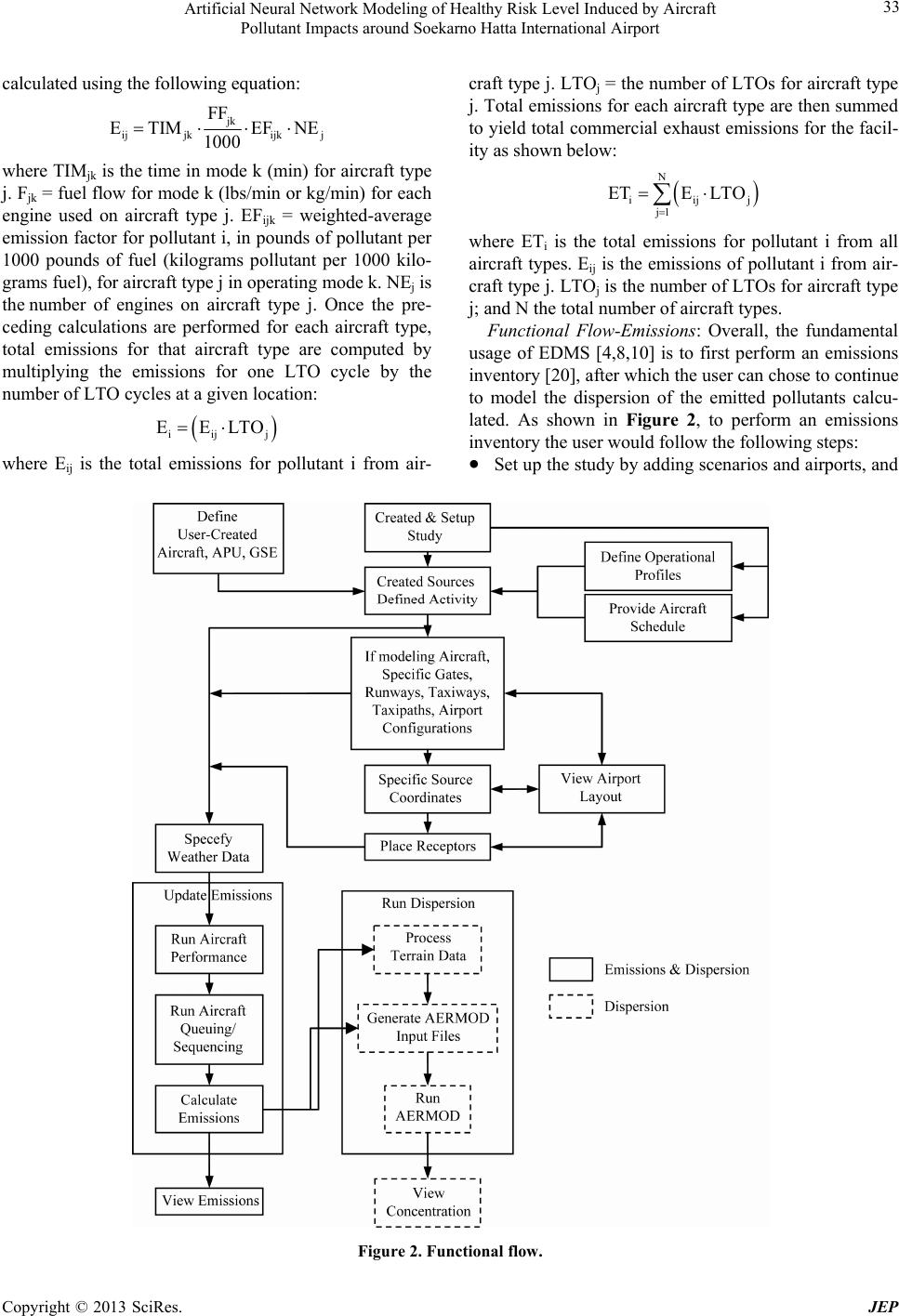 Artificial Neural Network Modeling of Healthy Risk Level Induced by Aircraft Pollutant Impacts around Soekarno Hatta International Airport Copyright © 2013 SciRes. JEP 33 craft type j. LTOj = the number of LTOs for aircraft type j. Total emissions for each aircraft type are then summed to yield total commercial exhaust emissions for the facil- ity as shown below: calculated using the following equation: jk ijjkijk j FF ETIMEFNE 1000 where TIMjk is the time in mode k (min) for aircraft type j. Fjk = fuel flow for mode k (lbs/min or kg/min) for each engine used on aircraft type j. EFijk = weighted-average emission factor for pollutant i, in pounds of pollutant per 1000 pounds of fuel (kilograms pollutant per 1000 kilo- grams fuel), for aircraft type j in operating mode k. NEj is the number of engines on aircraft type j. Once the pre- ceding calculations are performed for each aircraft type, total emissions for that aircraft type are computed by multiplying the emissions for one LTO cycle by the number of LTO cycles at a given location: iij EELTO j j N iij j1 ETE LTO where ETi is the total emissions for pollutant i from all aircraft types. Eij is the emissions of pollutant i from air- craft type j. LTOj is the number of LTOs for aircraft type j; and N the total number of aircraft types. Functional Flow-Emissions: Overall, the fundamental usage of EDMS [4,8,10] is to first perform an emissions inventory [20], after which the user can chose to continue to model the dispersion of the emitted pollutants calcu- lated. As shown in Figure 2, to perform an emissions inventory the user would follow the following steps: Set up the study by adding scenarios and airports, and where Eij is the total emissions for pollutant i from air- Figure 2. Functional flow. 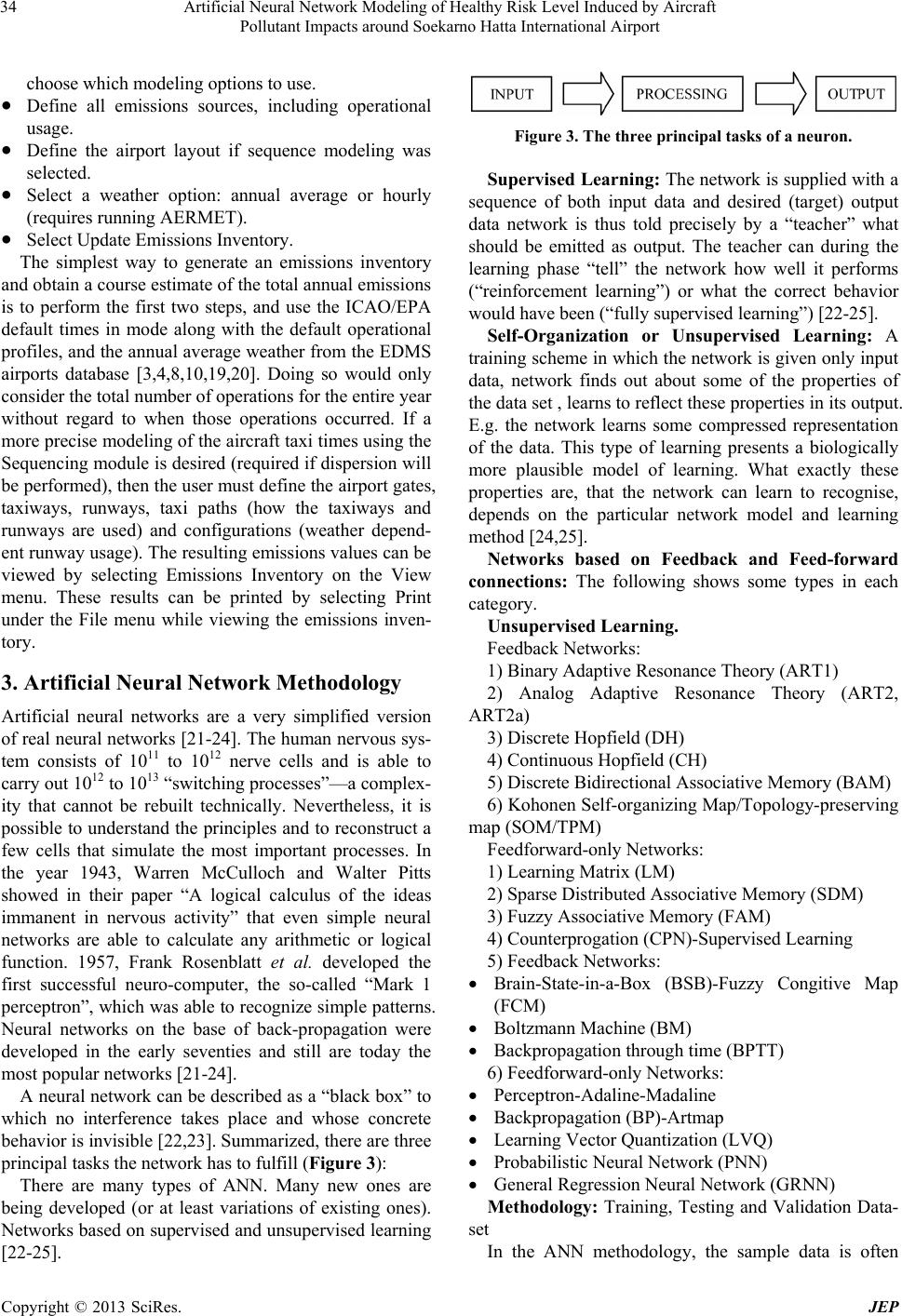 Artificial Neural Network Modeling of Healthy Risk Level Induced by Aircraft Pollutant Impacts around Soekarno Hatta International Airport 34 choose which modeling options to use. Define all emissions sources, including operational usage. Define the airport layout if sequence modeling was selected. Select a weather option: annual average or hourly (requires running AERMET). Select Update Emissions Inventory. The simplest way to generate an emissions inventory and obtain a course estimate of the total annual emissions is to perform the first two steps, and use the ICAO/EPA default times in mode along with the default operational profiles, and the annual average weather from the EDMS airports database [3,4,8,10,19,20]. Doing so would only consider the total number of operations for the entire year without regard to when those operations occurred. If a more precise modeling of the aircraft taxi times using the Sequencing module is desired (required if dispersion will be performed), then the user must define the airport gates, taxiways, runways, taxi paths (how the taxiways and runways are used) and configurations (weather depend- ent runway usage). The resulting emissions values can be viewed by selecting Emissions Inventory on the View menu. These results can be printed by selecting Print under the File menu while viewing the emissions inven- tory. 3. Artificial Neural Network Methodology Artificial neural networks are a very simplified version of real neural networks [21-24]. The human nervous sys- tem consists of 1011 to 1012 nerve cells and is able to carry out 1012 to 1013 “switching processes”—a complex- ity that cannot be rebuilt technically. Nevertheless, it is possible to understand the principles and to reconstruct a few cells that simulate the most important processes. In the year 1943, Warren McCulloch and Walter Pitts showed in their paper “A logical calculus of the ideas immanent in nervous activity” that even simple neural networks are able to calculate any arithmetic or logical function. 1957, Frank Rosenblatt et al. developed the first successful neuro-computer, the so-called “Mark 1 perceptron”, which was able to recognize simple patterns. Neural networks on the base of back-propagation were developed in the early seventies and still are today the most popular networks [21-24]. A neural network can be described as a “black box” to which no interference takes place and whose concrete behavior is invisible [22,23]. Summarized, there are three principal tasks the network has to fulfill (Figure 3): There are many types of ANN. Many new ones are being developed (or at least variations of existing ones). Networks based on supervised and unsupervised learning [22-25]. Figure 3. The three principal tasks of a neuron. Supervised Learning: The network is supplied with a sequence of both input data and desired (target) output data network is thus told precisely by a “teacher” what should be emitted as output. The teacher can during the learning phase “tell” the network how well it performs (“reinforcement learning”) or what the correct behavior would have been (“fully supervised learning”) [22-25]. Self-Organization or Unsupervised Learning: A training scheme in which the network is given only input data, network finds out about some of the properties of the data set , learns to reflect these properties in its output. E.g. the network learns some compressed representation of the data. This type of learning presents a biologically more plausible model of learning. What exactly these properties are, that the network can learn to recognise, depends on the particular network model and learning method [24,25]. Networks based on Feedback and Feed-forward connections: The following shows some types in each category. Unsupervised Learning. Feedback Networks: 1) Binary Adaptive Resonance Theory (ART1) 2) Analog Adaptive Resonance Theory (ART2, ART2a) 3) Discrete Hopfield (DH) 4) Continuous Hopfield (CH) 5) Discrete Bidirectional Associative Memory (BAM) 6) Kohonen Self-organizing Map/Topology-preserving map (SOM/TPM) Feedforward-only Networks: 1) Learning Matrix (LM) 2) Sparse Distributed Associative Memory (SDM) 3) Fuzzy Associative Memory (FAM) 4) Counterprogation (CPN)-Supervised Learning 5) Feedback Networks: Brain-State-in-a-Box (BSB)-Fuzzy Congitive Map (FCM) Boltzmann Machine (BM) Backpropagation through time (BPTT) 6) Feedforward-only Networks: Perceptron-Ada line-Madaline Backpropagation (BP)-Artmap Learning Vector Quantization (LVQ) Probabilistic Neural Network (PNN) General Regression Neural Network (GRNN) Methodology: Training, Testing and Validation Data- set In the ANN methodology, the sample data is often Copyright © 2013 SciRes. JEP 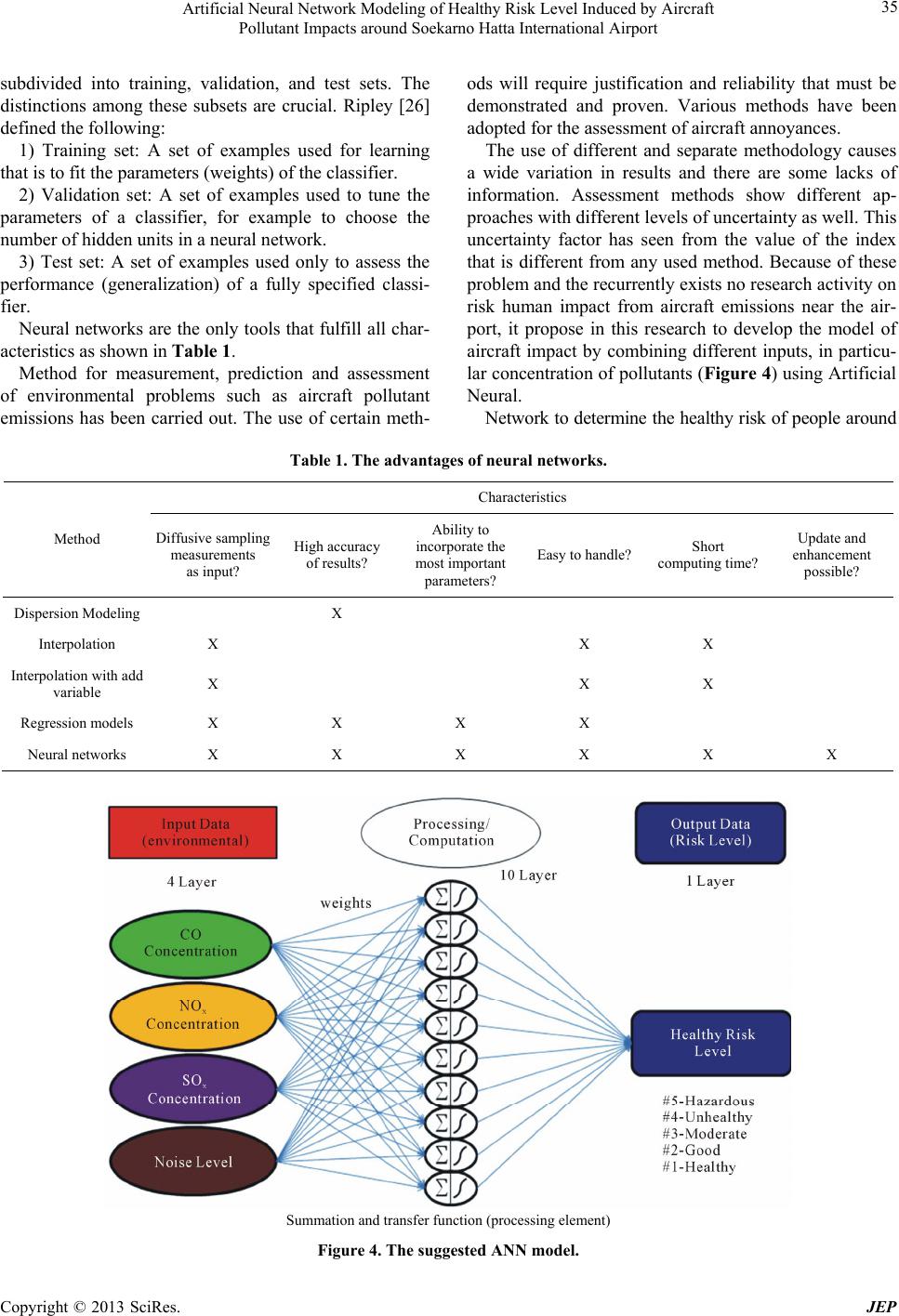 Artificial Neural Network Modeling of Healthy Risk Level Induced by Aircraft Pollutant Impacts around Soekarno Hatta International Airport 35 subdivided into training, validation, and test sets. The distinctions among these subsets are crucial. Ripley [26] defined the following: 1) Training set: A set of examples used for learning that is to fit the parameters (weights) of the classifier. 2) Validation set: A set of examples used to tune the parameters of a classifier, for example to choose the number of hidden units in a neural network. 3) Test set: A set of examples used only to assess the performance (generalization) of a fully specified classi- fier. Neural networks are the only tools that fulfill all char- acteristics as shown in Table 1. Method for measurement, prediction and assessment of environmental problems such as aircraft pollutant emissions has been carried out. The use of certain meth- ods will require justification and reliability that must be demonstrated and proven. Various methods have been adopted for the assessment of aircraft annoyances. The use of different and separate methodology causes a wide variation in results and there are some lacks of information. Assessment methods show different ap- proaches with different levels of uncertainty as well. This uncertainty factor has seen from the value of the index that is different from any used method. Because of these problem and the recurrently exists no research activity on risk human impact from aircraft emissions near the air- port, it propose in this research to develop the model of aircraft impact by combining different inputs, in particu- lar concentration of pollutants (Figure 4) using Artificial Neural. Network to determine the healthy risk of people around Table 1. The advantages of neural networks. Characteristics Method Diffusive sampling measurements as input? High accuracy of results? Ability to incorporate the most important parameters? Easy to handle?Short computing time? Update and enhancement possible? Dispersion Modeling X Interpolation X X X Interpolation with add variable X X X Regression models X X X X Neural networks X X X X X X Summation and transfer function (processing element) Figure 4. The suggested ANN model. Copyright © 2013 SciRes. JEP 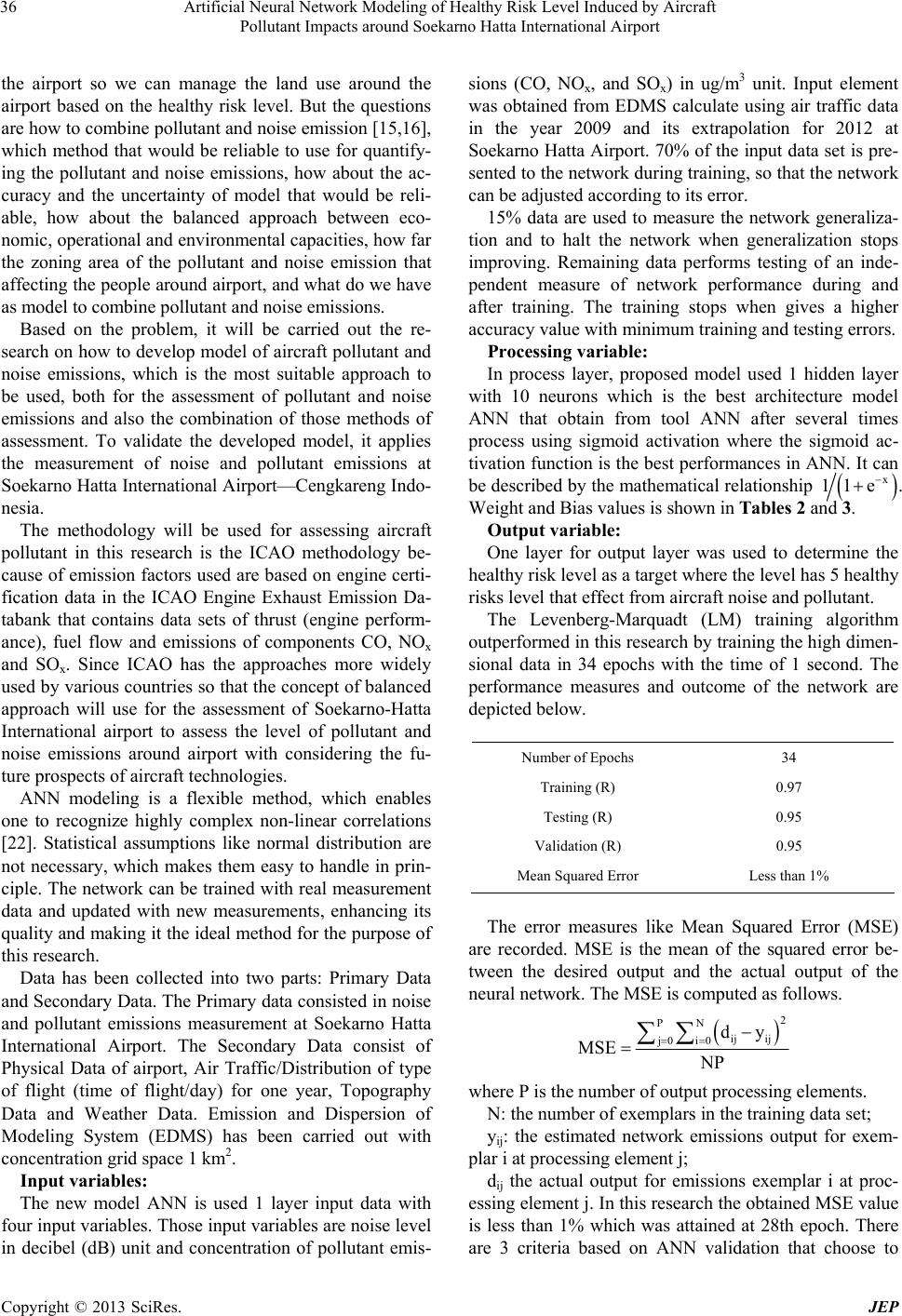 Artificial Neural Network Modeling of Healthy Risk Level Induced by Aircraft Pollutant Impacts around Soekarno Hatta International Airport 36 the airport so we can manage the land use around the airport based on the healthy risk level. But the questions are how to combine pollutant and noise emission [15,16], which method that would be reliable to use for quantify- ing the pollutant and noise emissions, how about the ac- curacy and the uncertainty of model that would be reli- able, how about the balanced approach between eco- nomic, operational and environmental capacities, how far the zoning area of the pollutant and noise emission that affecting the people around airport, and what do we have as model to combine pollutant and noise emissions. Based on the problem, it will be carried out the re- search on how to develop model of aircraft pollutant and noise emissions, which is the most suitable approach to be used, both for the assessment of pollutant and noise emissions and also the combination of those methods of assessment. To validate the developed model, it applies the measurement of noise and pollutant emissions at Soekarno Hatta International Airport—Cengkareng Indo- nesia. The methodology will be used for assessing aircraft pollutant in this research is the ICAO methodology be- cause of emission factors used are based on engine certi- fication data in the ICAO Engine Exhaust Emission Da- tabank that contains data sets of thrust (engine perform- ance), fuel flow and emissions of components CO, NOx and SOx. Since ICAO has the approaches more widely used by various countries so that the concept of balanced approach will use for the assessment of Soekarno-Hatta International airport to assess the level of pollutant and noise emissions around airport with considering the fu- ture prospects of aircraft technologies. ANN modeling is a flexible method, which enables one to recognize highly complex non-linear correlations [22]. Statistical assumptions like normal distribution are not necessary, which makes them easy to handle in prin- ciple. The network can be trained with real measurement data and updated with new measurements, enhancing its quality and making it the ideal method for the purpose of this research. Data has been collected into two parts: Primary Data and Secondary Data. The Primary data consisted in noise and pollutant emissions measurement at Soekarno Hatta International Airport. The Secondary Data consist of Physical Data of airport, Air Traffic/Distribution of type of flight (time of flight/day) for one year, Topography Data and Weather Data. Emission and Dispersion of Modeling System (EDMS) has been carried out with concentration grid space 1 km2. Input variable s: The new model ANN is used 1 layer input data with four input variables. Those input variables are noise level in decibel (dB) unit and concentration of pollutant emis- sions (CO, NOx, and SOx) in ug/m3 unit. Input element was obtained from EDMS calculate using air traffic data in the year 2009 and its extrapolation for 2012 at Soekarno Hatta Airport. 70% of the input data set is pre- sented to the network during training, so that the network can be adjusted according to its error. 15% data are used to measure the network generaliza- tion and to halt the network when generalization stops improving. Remaining data performs testing of an inde- pendent measure of network performance during and after training. The training stops when gives a higher accuracy value with minimum training and testing errors. Processing variable: In process layer, proposed model used 1 hidden layer with 10 neurons which is the best architecture model ANN that obtain from tool ANN after several times process using sigmoid activation where the sigmoid ac- tivation function is the best performances in ANN. It can be described by the mathematical relationship x 11 e . Weight and Bias values is shown in Tables 2 and 3. Output variable: One layer for output layer was used to determine the healthy risk level as a target where the level has 5 healthy risks level that effect from aircraft noise and pollutant. The Levenberg-Marquadt (LM) training algorithm outperformed in this research by training the high dimen- sional data in 34 epochs with the time of 1 second. The performance measures and outcome of the network are depicted below. Number of Epochs 34 Training (R) 0.97 Testing (R) 0.95 Validation (R) 0.95 Mean Squared Error Less than 1% The error measures like Mean Squared Error (MSE) are recorded. MSE is the mean of the squared error be- tween the desired output and the actual output of the neural network. The MSE is computed as follows. 2 PN j0 iij 0ij dy MSE P where P is the number of output processing elements. N: the number of exemplars in the training data set; yij: the estimated network emissions output for exem- plar i at processing element j; dij the actual output for emissions exemplar i at proc- essing element j. In this research the obtained MSE value is less than 1% which was attained at 28th epoch. There are 3 criteria based on ANN validation that choose to Copyright © 2013 SciRes. JEP  Artificial Neural Network Modeling of Healthy Risk Level Induced by Aircraft Pollutant Impacts around Soekarno Hatta International Airport 37 Table 2. Healthy risk level. Pollutant Emissions Risk Score Level CO (µg/m3) NOx (µg/m3) SOx (µg/m3) Noise (dB) Additional and not necessary input #5 Hazardous >200 >200 >200 >85 #4 Unhealthy 100 - 200 99.64 - 200 85.8 - 200 70 - 85 #3 Moderate 50 - 100 50 - 99.64 50 - 85.8 60 - 70 #2 Good 25 - 50 25 - 50 25 - 50 50 - 60 #1 Healthy <25 <25 <25 <50 Table 3. Network weights and bias values. Weights Bias Input Hidden (IW) CO NOx SOx Noise: additional index Hidden Output (LW) (b1) (b2) w1 0.1407 −0.35259 2.2921 −1.1287 1.2221 b1 2.1849 1.2555 w2 −1.4491 −0.18607 −1.8873 −0.26701 1.1295 b2 2.0254 w3 1.3516 2.9137 0.27905 0.89349 2.3592 B3 −2.8272 w4 1.4867 −0.48544 −1.5046 −1.5885 −0.75403 b4 −1.1238 w5 −1.2303 −0.84468 1.1476 1.0959 −3.8315 b5 0.73 w6 0.93944 0.82249 −1.0546 2.368 −0.20789 b6 −2.4039 w7 −0.37134 0.88173 −0.88702 −1.3128 −1.1142 b7 −0.28432 w8 −0.18717 −1.8745 0.024024 5.5257 3.3151 b8 3.8534 w9 −0.8133 1.2728 0.49045 1.2881 1.0377 b9 −2.834 w10 1.4671 2.4003 0.22196 0.2502 −0.77638 b10 3.7339 validate the proposed of new model. Criteria 1 (Figure 5) is based on performance, Criteria 2 (Figure 6) is based on Regression R Value and Criteria 3 (Figure 7) is based on networks output errors. All Criteria give a best result of proposed ANN network. In Criteria 1, best validation performance is achieved at epoch 28 from 34 epochs (Mean Squared Error is 0.0093521). The correlation (Criteria 2) between target and output is validated at R = 0.95756, means there is a close relation between target and output. Criteria 3 show network output errors. The range error value is close to zero (−0.4 - 0.6). According to ANN Criteria it can be say that the proposed model is valid. All the results are shown in below. The example result of simulation for Soekarno Hatta Airport, taking into account 2012 air traffic, is given in the following table. Pollutants considered were CO, HC, Figure 5. Criteria 1. Copyright © 2013 SciRes. JEP 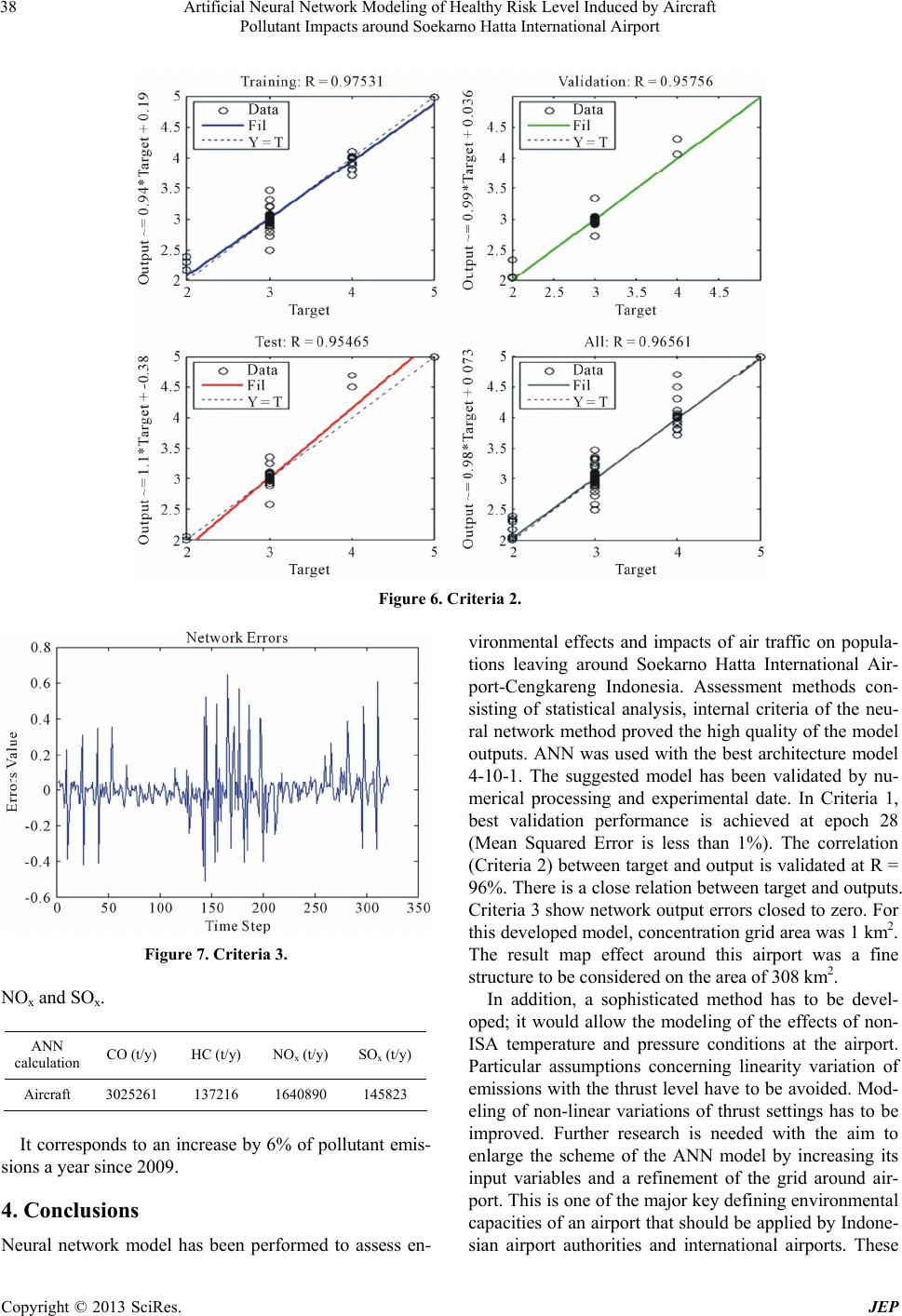 Artificial Neural Network Modeling of Healthy Risk Level Induced by Aircraft Pollutant Impacts around Soekarno Hatta International Airport 38 Figure 6. Criteria 2. Figure 7. Criteria 3. NOx and SOx. ANN calculation CO (t/y) HC (t/y) NOx (t/y) SOx (t/y) Aircraft 3025261 137216 1640890 145823 It corresponds to an increase by 6% of pollutant emis- sions a year since 2009. 4. Conclusions Neural network model has been performed to assess en- vironmental effects and impacts of air traffic on popula- tions leaving around Soekarno Hatta International Air- port-Cengkareng Indonesia. Assessment methods con- sisting of statistical analysis, internal criteria of the neu- ral network method proved the high quality of the model outputs. ANN was used with the best architecture model 4-10-1. The suggested model has been validated by nu- merical processing and experimental date. In Criteria 1, best validation performance is achieved at epoch 28 (Mean Squared Error is less than 1%). The correlation (Criteria 2) between target and output is validated at R = 96%. There is a close relation between target and outputs. Criteria 3 show network output errors closed to zero. For this developed model, concentration grid area was 1 km2. The result map effect around this airport was a fine structure to be considered on the area of 308 km2. In addition, a sophisticated method has to be devel- oped; it would allow the modeling of the effects of non- ISA temperature and pressure conditions at the airport. Particular assumptions concerning linearity variation of emissions with the thrust level have to be avoided. Mod- eling of non-linear variations of thrust settings has to be improved. Further research is needed with the aim to enlarge the scheme of the ANN model by increasing its input variables and a refinement of the grid around air- port. This is one of the major key defining environmental capacities of an airport that should be applied by Indone- sian airport authorities and international airports. These Copyright © 2013 SciRes. JEP 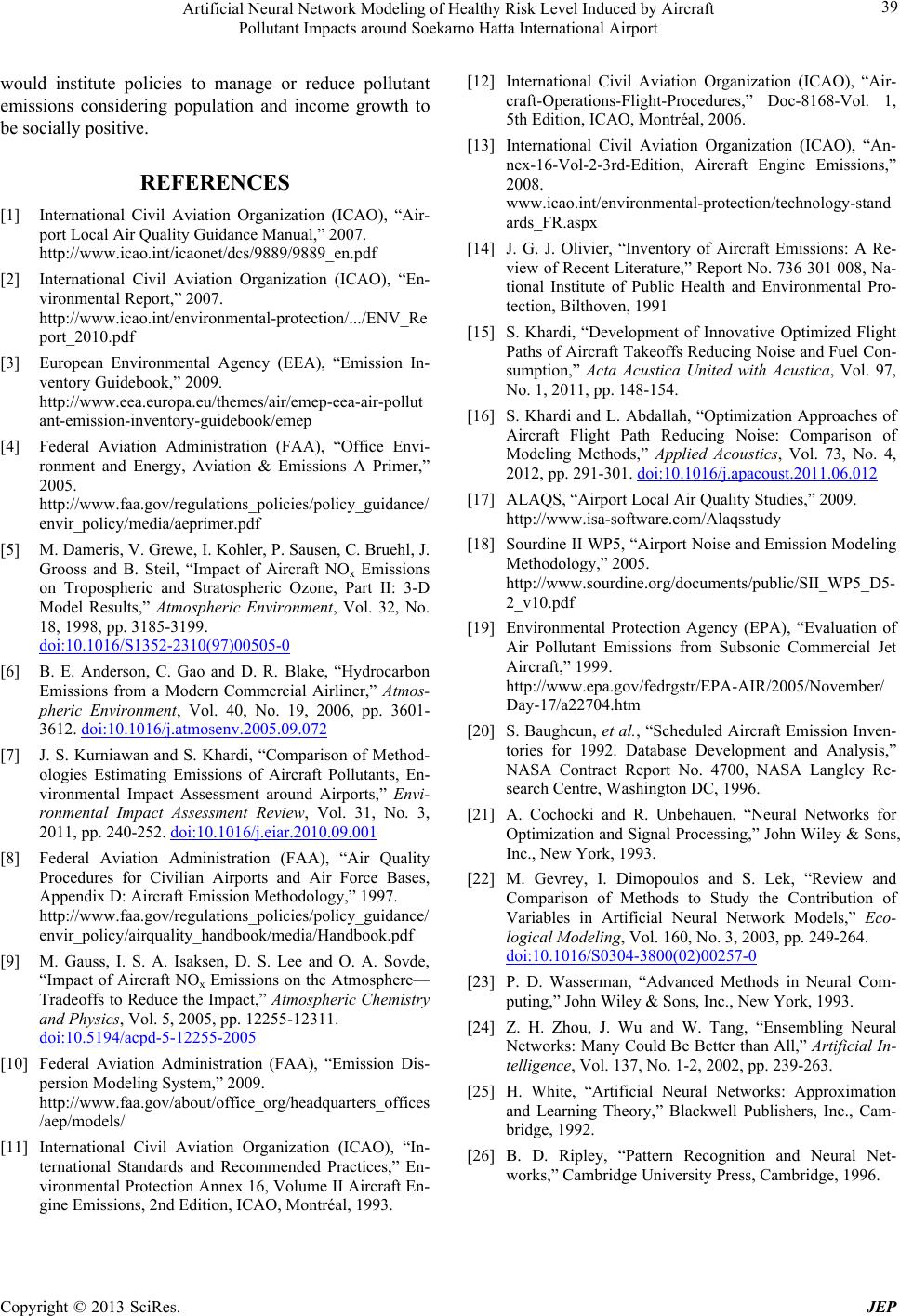 Artificial Neural Network Modeling of Healthy Risk Level Induced by Aircraft Pollutant Impacts around Soekarno Hatta International Airport 39 would institute policies to manage or reduce pollutant emissions considering population and income growth to be socially positive. REFERENCES [1] International Civil Aviation Organization (ICAO), “Air- port Local Air Quality Guidance Manual,” 2007. http://www.icao.int/icaonet/dcs/9889/9889_en.pdf [2] International Civil Aviation Organization (ICAO), “En- vironmental Report,” 2007. http://www.icao.int/environmental-protection/.../ENV_Re port_2010.pdf [3] European Environmental Agency (EEA), “Emission In- ventory Guidebook,” 2009. http://www.eea.europa.eu/themes/air/emep-eea-air-pollut ant-emission-inventory-guidebook/emep [4] Federal Aviation Administration (FAA), “Office Envi- ronment and Energy, Aviation & Emissions A Primer,” 2005. http://www.faa.gov/regulations_policies/policy_guidance/ envir_policy/media/aeprimer.pdf [5] M. Dameris, V. Grewe, I. Kohler, P. Sausen, C. Bruehl, J. Grooss and B. Steil, “Impact of Aircraft NOx Emissions on Tropospheric and Stratospheric Ozone, Part II: 3-D Model Results,” Atmospheric Environment, Vol. 32, No. 18, 1998, pp. 3185-3199. doi:10.1016/S1352-2310(97)00505-0 [6] B. E. Anderson, C. Gao and D. R. Blake, “Hydrocarbon Emissions from a Modern Commercial Airliner,” Atmos- pheric Environment, Vol. 40, No. 19, 2006, pp. 3601- 3612. doi:10.1016/j.atmosenv.2005.09.072 [7] J. S. Kurniawan and S. Khardi, “Comparison of Method- ologies Estimating Emissions of Aircraft Pollutants, En- vironmental Impact Assessment around Airports,” Envi- ronmental Impact Assessment Review, Vol. 31, No. 3, 2011, pp. 240-252. doi:10.1016/j.eiar.2010.09.001 [8] Federal Aviation Administration (FAA), “Air Quality Procedures for Civilian Airports and Air Force Bases, Appendix D: Aircraft Emission Methodology,” 1997. http://www.faa.gov/regulations_policies/policy_guidance/ envir_policy/airquality_handbook/media/Handbook.pdf [9] M. Gauss, I. S. A. Isaksen, D. S. Lee and O. A. Sovde, “Impact of Aircraft NOx Emissions on the Atmosphere— Tradeoffs to Reduce the Impact,” Atmospheric Chemistry and Physics, Vol. 5, 2005, pp. 12255-12311. doi:10.5194/acpd-5-12255-2005 [10] Federal Aviation Administration (FAA), “Emission Dis- persion Modeling System,” 2009. http://www.faa.gov/about/office_org/headquarters_offices /aep/models/ [11] International Civil Aviation Organization (ICAO), “In- ternational Standards and Recommended Practices,” En- vironmental Protection Annex 16, Volume II Aircraft En- gine Emissions, 2nd Edition, ICAO, Montréal, 1993. [12] International Civil Aviation Organization (ICAO), “Air- craft-Operations-Flight-Procedures,” Doc-8168-Vol. 1, 5th Edition, ICAO, Montréal, 2006. [13] International Civil Aviation Organization (ICAO), “An- nex-16-Vol-2-3rd-Edition, Aircraft Engine Emissions,” 2008. www.icao.int/environmental-protection/technology-stand ards_FR.aspx [14] J. G. J. Olivier, “Inventory of Aircraft Emissions: A Re- view of Recent Literature,” Report No. 736 301 008, Na- tional Institute of Public Health and Environmental Pro- tection, Bilthoven, 1991 [15] S. Khardi, “Development of Innovative Optimized Flight Paths of Aircraft Takeoffs Reducing Noise and Fuel Con- sumption,” Acta Acustica United with Acustica, Vol. 97, No. 1, 2011, pp. 148-154. [16] S. Khardi and L. Abdallah, “Optimization Approaches of Aircraft Flight Path Reducing Noise: Comparison of Modeling Methods,” Applied Acoustics, Vol. 73, No. 4, 2012, pp. 291-301. doi:10.1016/j.apacoust.2011.06.012 [17] ALAQS, “Airport Local Air Quality Studies,” 2009. http://www.isa-software.com/Alaqsstudy [18] Sourdine II WP5, “Airport Noise and Emission Modeling Methodology,” 2005. http://www.sourdine.org/documents/public/SII_WP5_D5- 2_v10.pdf [19] Environmental Protection Agency (EPA), “Evaluation of Air Pollutant Emissions from Subsonic Commercial Jet Aircraft,” 1999. http://www.epa.gov/fedrgstr/EPA-AIR/2005/November/ Day-17/a22704.htm [20] S. Baughcun, et al., “Scheduled Aircraft Emission Inven- tories for 1992. Database Development and Analysis,” NASA Contract Report No. 4700, NASA Langley Re- search Centre, Washington DC, 1996. [21] A. Cochocki and R. Unbehauen, “Neural Networks for Optimization and Signal Processing,” John Wiley & Sons, Inc., New York, 1993. [22] M. Gevrey, I. Dimopoulos and S. Lek, “Review and Comparison of Methods to Study the Contribution of Variables in Artificial Neural Network Models,” Eco- logical Modeling, Vol. 160, No. 3, 2003, pp. 249-264. doi:10.1016/S0304-3800(02)00257-0 [23] P. D. Wasserman, “Advanced Methods in Neural Com- puting,” John Wiley & Sons, Inc., New York, 1993. [24] Z. H. Zhou, J. Wu and W. Tang, “Ensembling Neural Networks: Many Could Be Better than All,” Artificial In- telligence, Vol. 137, No. 1-2, 2002, pp. 239-263. [25] H. White, “Artificial Neural Networks: Approximation and Learning Theory,” Blackwell Publishers, Inc., Cam- bridge, 1992. [26] B. D. Ripley, “Pattern Recognition and Neural Net- works,” Cambridge University Press, Cambridge, 1996. Copyright © 2013 SciRes. JEP
|